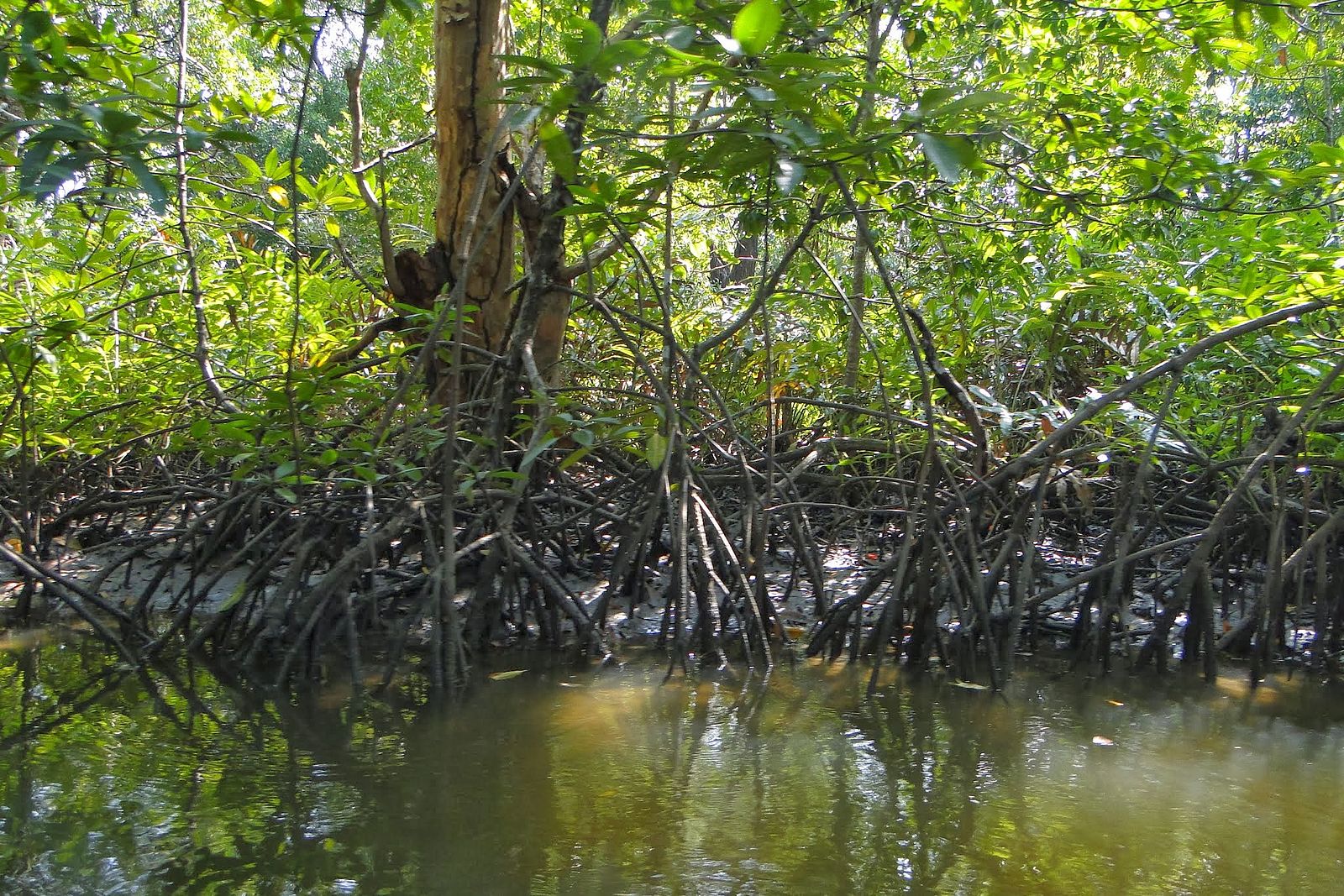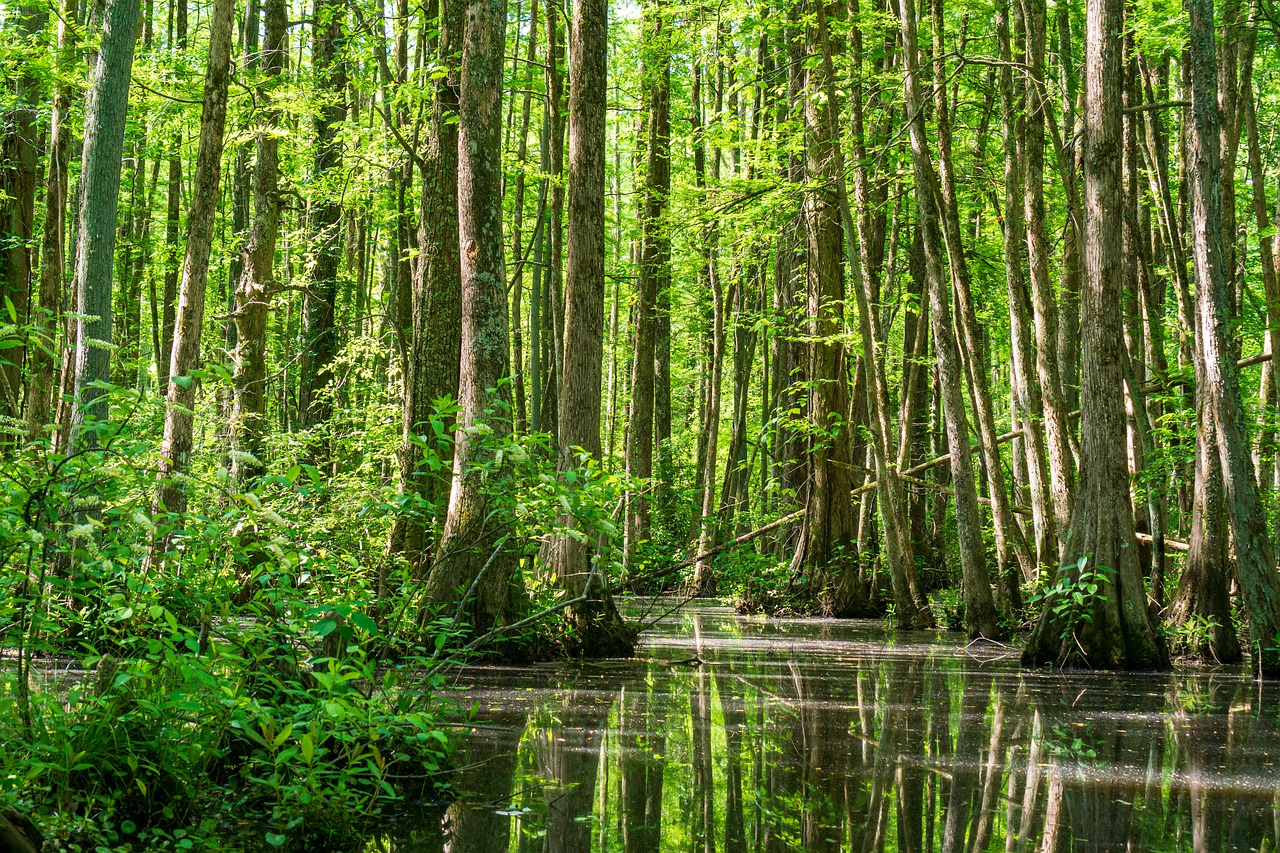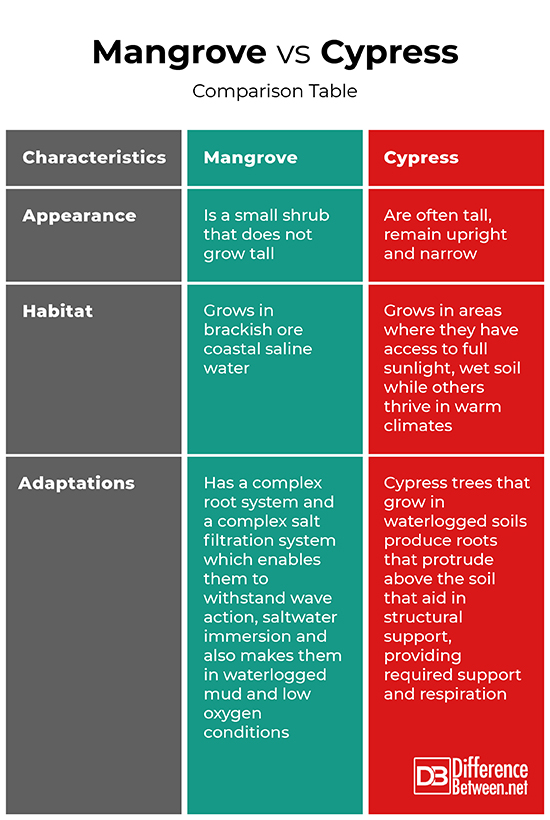Difference Between Mangrove and Cypress
The world would be inhabitable without vegetation. While there are over 320,000 of plant species in the world, these differ according to adaptations, root systems, production of flowers and favourable conditions, just to name a few. The mangrove and cypress trees can be easily confused, given that they can both survive in swampy areas. The two, however, have differences.

What is a Mangrove?
This is a small tree that grows in brackish or coastal saline water. They grow in latitudes between 25° N and 25° S in the tropics and subtropics. Worldwide, the total mangrove covers 137,800 square kilometres in 118 territories and countries as per 2000.
These trees contain a complex root system and a complex salt filtration system which enables them to withstand wave action and saltwater immersion. This also makes them in waterlogged mud and low oxygen conditions.
According to a study by NASA, the mangrove forests are among the planet’s best carbon scrubbers due to their ability to move carbon dioxide in greater quantities to long-term storage as compared to other forests.
Although only a few species are from the mangrove plant species, Rhizophora, about 110 species are classified in this category.

What is Cypress?
Derived from the French term cipres, this is a common term for trees that belong to the family Cupressaceae and are found in the northern temperate regions.
The trees is popular for its flat canopy appearance that resembles an open umbrella. It also has different shades of green ranging from light green to dark green. The tress also yields small cones that contain more than 30 seeds.
There are many types of cypress tress such as Leyland Cypress, Arizona Cypress, Bald Cypress and Italian Cypress, just to name a few.
The tress grows in areas where they have access to full sunlight, wet soil while others thrive in warm climates. Cypress trees that grow in waterlogged soils produce roots that protrude above the soil that aid in structural support, providing required support and respiration. Among popular uses of these trees include making tables, boats, bridges, roofing shingles and bed frames.
Similarities between Mangrove and Cypress
- Both can grow in swampy areas
- Both are flood-tolerant
Differences between Mangrove and Cypress
Appearance
While mangrove is a small shrub that does not grow tall, cypress trees are often tall, remain upright and narrow.
Habitat
While the mangrove grows in brackish ore coastal saline water, cypress grows in areas where they access to full sunlight, wet soil while others thrive in warm climates.
Adaptations
The mangrove has a complex root system and a complex salt filtration system which enables them to withstand wave action, saltwater immersion and also makes them in waterlogged mud and low oxygen conditions. On the other hand, the cypress trees that grow in waterlogged soils produce roots that protrude above the soil that aid in structural support, providing required support and respiration.
Mangrove vs. Cypress: Comparison Table

Summary of Mangrove vs. Cypress
The mangrove is a small tree that grows in brackish or coastal saline water. It has a complex root system and a complex salt filtration system which enables them to withstand wave action, saltwater immersion and also makes them in waterlogged mud and low oxygen conditions. On the other hand, cypress trees grows in areas where they have access to full sunlight, wet soil while others thrive in warm climates. Both, however, can grow in swampy areas and are flood tolerant.
- Difference Between Profit Center and Investment Center - July 2, 2022
- Difference Between Anti-Trust and Anti-Competition - June 6, 2022
- Difference Between Stocktaking and Stock Control - June 6, 2022
Search DifferenceBetween.net :
1 Comment
Leave a Response
References :
[0]Sahadev Sharma. Mangrove Ecosystem Ecology and Function. BoD – Books on Demand, 2018. https://books.google.co.ke/books?id=Gm-QDwAAQBAJ&pg=PA34&dq=mangrove+trees&hl=en&sa=X&ved=2ahUKEwiN--X1jajrAhXCDGMBHQFXDWgQ6AEwBHoECAQQAg#v=onepage&q=mangrove%20trees&f=false
[1]Volker Linneweber. Mangrove Ecosystems: Function and Management. Springer Science & Business Media, 2013. https://books.google.co.ke/books?id=-NytBAAAQBAJ&pg=PT200&dq=mangrove+trees&hl=en&sa=X&ved=2ahUKEwiN--X1jajrAhXCDGMBHQFXDWgQ6AEwA3oECAUQAg#v=onepage&q=mangrove%20trees&f=false
[2]Jonathan Drori. Around the World in 80 Trees. Laurence King Publishing, 2018. https://books.google.co.ke/books?id=_CHyDwAAQBAJ&pg=PA71&dq=cypress+trees+in+the+world&hl=en&sa=X&ved=2ahUKEwjSsqzRj6jrAhXl4IUKHV9ADdIQ6AEwAHoECAAQAg#v=onepage&q=cypress%20trees%20in%20the%20world&f=false
[3]Image credit: https://cdn.pixabay.com/photo/2020/05/12/19/29/cypress-forest-reflection-5164648_1280.jpg
[4]Image credit: https://commons.wikimedia.org/wiki/File:Mangrove-1.JPG

They don’t appear to have contradictions in their definitions. Why can’t a cypress tree be called a mangrove tree? Or is a mangrove tree a particular type of tree, not just a general description.